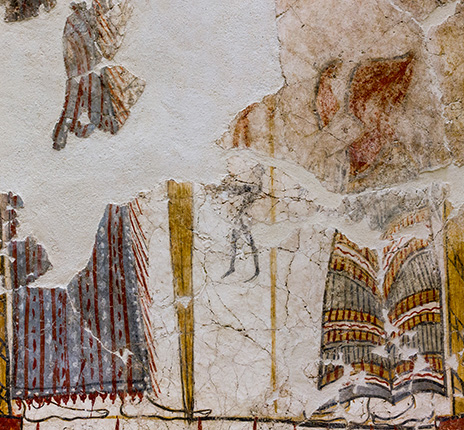Gorgeous Tangents – A blog with meticulous research and stunning reproductions of several outfits. Pages of particular interest:
Ariadne’s Threads: The Construction and Significance of Clothes in the Aegean Bronze Age – An excellent book, though somewhat marred by the author’s limited knowledge of weaving. Unfortunately, it’s expensive as hell. It was submitted as the author’s dissertation, so if you can locate a copy, it will probably be cheaper and will contain most of what’s in the published version.
Crete
Home of the Minoan culture, taken over by the Mycenaean Greeks around 1450 BCE.
Knossos – A primary palatial site for both the Minoans and the Mycenaean Greeks.
Hagia Triada
Greece
Mycenae
Pylos
Thebes
Tiryns
Santorini
An island that was the site of a heavily Minoan-influenced culture until the 16th century BCE, when the island’s volcano, Thera, erupted, sinking a huge portion of the island and burying the rest.
Akrotiri – A settlement that was buried, Pompeii-like, in the 16th century BCE. The buildings are preserved up to the second story, and occasionally up to the third, along with frescoes and plentiful objects from daily life.
1700-1600 BCE
1600-1500 BCE
1500-1400 BCE – The Minoans went into decline and the Mycenaean Greeks took control of Crete around 1450 BCE.
1400-1300 BCE
1300-1200 BCE
1200-1100 BCE – The Bronze Age Collapse began around 1200 BCE. Troy was destroyed around 1184 BCE, Knossos was burnt around 1180 BCE, and most of the other Greek cities (along with almost all of the other Mediterranean civilizations) collapsed or were severely weakened during this period. Linear B died out with the disappearance of the palatial bureaucracies, ushering in the 400-year-long Greek Dark Age.
Heanos: The long dress worn as a base garment, sometimes as the only garment. Comes in both tight and loose variants; if no variant is mentioned, the heanos is tight.
In some art, especially in seals and signet rings, the heanos is depicted with horizontal or vertical lines representing either decoration or folds. When these are present, it will be noted.
Jacket: A short jacket worn over the heanos, the same color as the heanos but with reverse-colored trim. Identifiable mainly by the diagonal line of the trim along the rear point.
Kilt: The wrapped skirt with pointed tiers and an opening down the front.
Tiered skirt: The full-length tiered skirt with no opening down the front. Unlike the kilt, the tiers are even and horizontal all the way around.
Shaggy skirt: A white, shaggy-looking overskirt that may be made from animal hide. Worn by both sexes.
Apron: The short, apron-like garment (with flaps both in front and behind) that is worn over another skirt by a few women. This is usually a male garment.
Wrap: A wide scarf or dupatta-like wrap.
